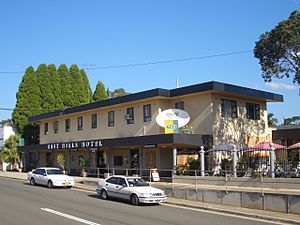East Hills, New South Wales facts for kids
Quick facts for kids East HillsSydney, New South Wales |
|||||||||||||||
|---|---|---|---|---|---|---|---|---|---|---|---|---|---|---|---|

Maclaurin Avenue, East Hills
|
|||||||||||||||
| Population | 3,206 (2016 census) | ||||||||||||||
| Postcode(s) | 2213 | ||||||||||||||
| Elevation | 14 m (46 ft) | ||||||||||||||
| Location | 26 km (16 mi) south-west of Sydney CBD | ||||||||||||||
| LGA(s) | City of Canterbury-Bankstown | ||||||||||||||
| State electorate(s) | East Hills | ||||||||||||||
| Federal Division(s) | Banks | ||||||||||||||
|
|||||||||||||||
East Hills is a suburb in Sydney, New South Wales, Australia. It is located about 26 kilometers southwest of the main Sydney central business district. East Hills is part of the City of Canterbury-Bankstown area.
This small suburb sits on the northern side of the Georges River. Its neighbors include Panania and Picnic Point. Across the Georges River, you can find suburbs like Pleasure Point and Sandy Point.
Contents
History of East Hills
East Hills was once the name for a much larger area. This area stretched from south of Bankstown all the way to the Georges River.
Early Land Grants
In 1804, a person named George Johnstone received a large piece of land here. He called his property "New Jerusalem." Later, a tenant named Robert Gardiner named his farm "East Hills." This name might have come from a place near Liverpool, England.
In 1828, Thomas Graham was granted more land, which he later sold. Another part of the area was bought by George Nicholas Weston in 1838.
Developing the Suburb
The area was officially divided into smaller plots in 1893. This is when it was formally named East Hills, after the farm.
The railway line reached East Hills in 1931. For many years, East Hills was the end of the train line. In 1987, the line was extended further. This new extension connected East Hills to other areas like Holsworthy and Glenfield. This made it easier for people from places like Minto and Campbelltown to travel to the city.
Who Lives in East Hills?
According to the 2016 census, about 3,206 people lived in East Hills.
Backgrounds and Languages
Most people (63%) living in East Hills were born in Australia. About 53.6% of homes spoke only English. Other common languages spoken at home included Arabic (11.6%) and Vietnamese (6.4%).
Ancestry and Religion
The most common backgrounds people identified with were Australian (18.5%) and English (16.1%). Other ancestries included Lebanese (8.5%), Chinese (7.1%), and Irish (5.6%).
For religion, the most common choices were Catholic (27.8%), No Religion (16.4%), and Anglican (12.2%).
Shops and Services
East Hills has a small shopping area. You can find these shops on Maclaurin Avenue. They are located right next to the East Hills railway station. The East Hills Hotel is also in this area.
Getting Around East Hills
East Hills has good transport options for its residents.
Train Services
The East Hills railway station is part of the Sydney Trains network. It is on the Airport & South Line, which connects to many parts of Sydney.
Bus Services
Some parts of East Hills are served by buses. These buses are operated by U-Go Mobility. They generally follow the routes that were set up by McVicar's Bus Services a long time ago.
Schools in East Hills
East Hills is home to several schools for students of different ages.
- East Hills Primary School
- East Hills Boys High School
- East Hills Girls Technology High School
Sports and Activities
East Hills has active sports clubs for young people.
- The suburb has a successful baseball club.
- The East Hills Bulldogs play in the Canterbury-Bankstown District Junior Rugby League. Their home ground is Smith Park.
Images for kids






